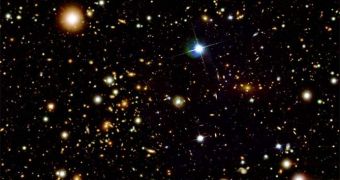A series of recent experiments has revealed that, more often than not, the halos of dark matter surrounding massive galaxy clusters are flattened and shaped like a cigar. Until now, astrophysicists believed that the mysterious stuff, which is believed to be five times more abundant than regular matter around the Universe, would clump up in rounded spheres. However, observations appear to paint a different picture, and experts are currently working on models that would help explain that.
The discovery could finally lead to studies that would result in the direct detection of the peculiar type of matter, whose existence can only be inferred from the gravitational pull it exerts on normal matter around it. “There are clear theoretical predictions that we expect dark mater halos to be flattened like this. It's a very beautiful, very clean and direct measurement of that,” explains expert Graham P. Smith, who is based at the University of Birmingham, in the United Kingdom. He is also a coauthor of the new study, which will appear in an upcoming issue of the esteemed scientific publication Monthly Notices of the Royal Astronomical Society.
In the new studies, the investigators looked at about 20 galaxy clusters, which are massive collections of galaxies, held together by strong gravitational interactions. In order to see the effect dark matter has on the largest organized structures in the Universe, the researchers used gravitational lensing. This observations technique analyzes how much light is bent when mass wraps time-space in order to determine the mass of celestial objects beyond. The Mauna Kea, Hawaii-based Subaru Telescope was used for the study, and the team took advantage of the Prime Focus Camera above all other instruments.
“What we're probing with these gravitational lensing observations is the dark matter distribution, because the dark matter dominates the mass on these large scales,” Smith says. The research team in charge of the study was led by National Astronomical Observatory of Japan expert Masamune Oguri and University of Tokyo scientist Masahiro Takada. The cigar-like shapes of these dark matter halos have been predicted in computer models of the cold dark matter theory, but thus far they have not been evidenced in practice in such a large number of galaxy clusters, Space reports.

 14 DAY TRIAL //
14 DAY TRIAL //